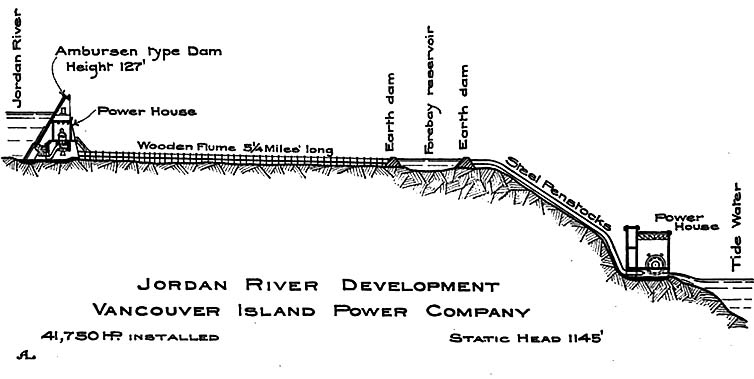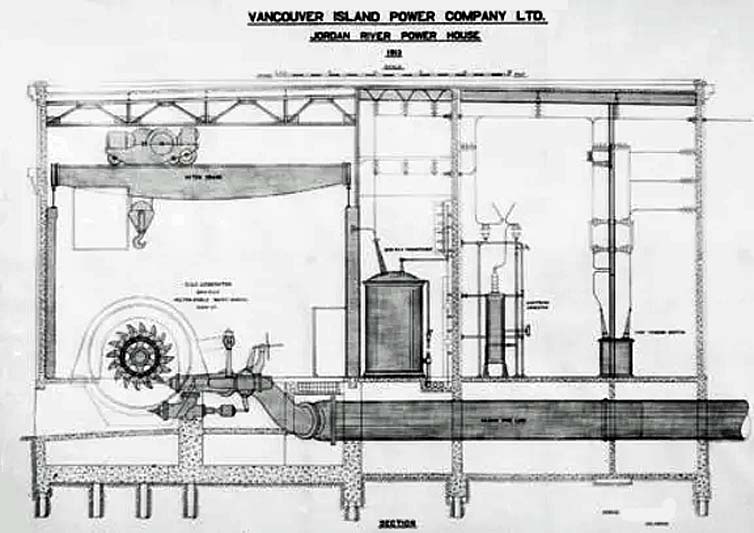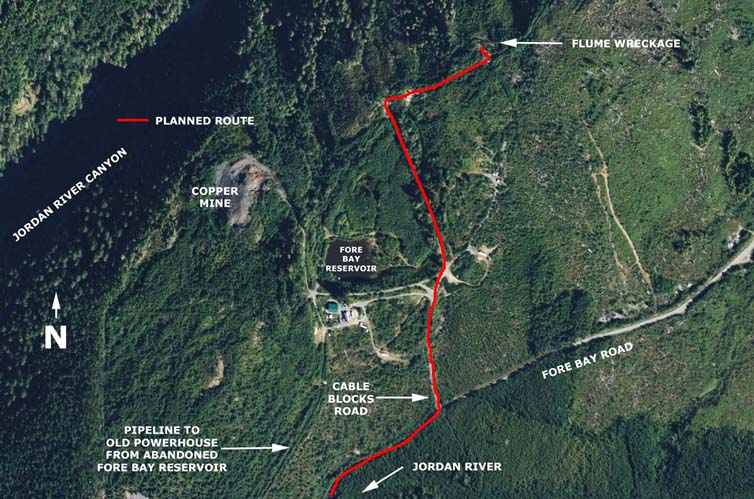 |  History |
1898 saw hydro electric power in Victoria supplied by a hydro electric plant on the Goldstream watershed.
The growing community needed more electricity so in 1909 construction of the Bear Creek Dam, Diversion Dam, Fore Bay reservoir, flume, penstocks, and a power plant near the ocean to house the generators was commenced by the Vancouver Island Power Company, a subsiduary of BCER, on the Jordan River watershed.
To enable construction in this remote area, and later maintenance, of a dam and flume a 3 foot narrow gauge railway was carved into the hills along the path of the Jordan River.
Initially the railway was horse-powered, but a Davenport 0-4-0ST steam locomotive acquired from the Esquimalt Waterworks Company was soon put to work. (Esquimalt Waterworks ceased activity in 1925 with operations taken over by the City of Victoria.)
steam locomotive acquired from the Esquimalt Waterworks Company was soon put to work. (Esquimalt Waterworks ceased activity in 1925 with operations taken over by the City of Victoria.)
This engine was later used at the Stave Falls hydro power plant over on the mainland in the Fraser Valley.
To carry the water from the Diversion Dam Reservoir a wooden flume 5.98 miles (9.3 kilometres) long was constructed from the dam southwards along the east side of the Jordan River valley to the smaller Fore Bay Reservoir.
Penstocks from that reservoir continued south to the hill above the power plant where there was a steep drop down to the plant.
An inclined railway led from the power plant up the hill close to the penstock.
Between 1912 and 1930 additional generators were added pushing the output of Jordan River's power plant up to 26 megawatts.
In 1961 BC Hydro was created by the provincial government by expropriating the assets of the BC Electric Railway Company.
They kept the flume and railway in use until 1971 when a new power plant was constructed on the west side of the river valley not far from the beach.
A 4.3 mile (7 kilometres) tunnel was completed from the new Elliott Dam and reservoir created on the Jordan River south of the Diversion Dam to this new power plant also on the west side of the river.
The wooden flume, which had been in use for 60 years, was therefore no longer required.
Unlike the old power plant which only produced 26 megawatts of power at its maximum this new one supplies 175 megawatts to the Island's grid.
Currently 80 percent of electricity on Vancouver Island is provided by a submarine cable from the mainland.
Today's Jordan River power is utilized to "top up" that mainland power during peak demand periods or in case of an emergency.
A 2014 BC Hydro study indicated the Diversion Dam had a high risk of seismic dam failure so BC Hydro offered to purchase nine residences located in the danger zone below the dam.
While construction of this hydro electric generating system has been a boon to Vancouver Island residents there has been a downside to human intrusion along the river.
A copper mine begun in the early 1900s near the Fore Bay Reservior has poisened the Jordan River so badly there are no longer any salmon runs.
In 1961 a 6 inch (15 centimetres) pipe was installed from the mine site to carry toxic mine tailings to the ocean where the toxic chemicals are released a kilometre from the beach.
I searched for remains of the Jordan River flume using satellite images and located what appears to be wreckage just north of the abandoned Fore Bay Reservoir. Unfortunately, private property surounds that area and access on a public gravel road was blocked by a private land owner who had stretched a cable across the road and posted large No Trespassing signs on either side of the cable.
Searching for the flume was important as the 3 foot narrow gauge railway paralleled the flume on the up side of the valley from Fore Bay Reservoir to the Diversion Dam.
A public gravel road, Fore Bay Road, from Highway 14, the West Coast Road, leads north along the river valley all the way to the Diversion Dam.
Driving this loosly named "road", rough with great pot holes, showed no signs of any railway right-of-way whatsoever.
Travelling the route indicated that part of this current gravel road is likely the original railway right-of-way cut into the Jordan River Valley hills.
Even so, there was no sign of any flume wreckage or railway remains to be seen driving along the route.





















